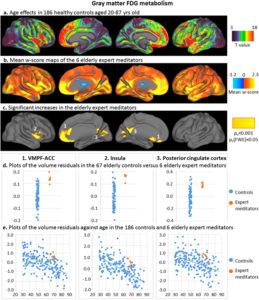Improve Alzheimer’s Disease Risk Factors with Mindfulness
By John M. de Castro, Ph.D.
“MBSR may reduce hippocampal atrophy and improve functional connectivity in the same areas of the brain most affected by Alzheimer’s disease. MBSR is a relatively simple intervention, with very little downside that may provide real promise for these individuals who have very few treatment options.” – Rebecca Wells
In the course of normal aging, there is a slow decline in cognitive ability. But, for some the decline can be excessive producing dementia. Alzheimer’s disease is the most common form of dementia. It involves an irreversible progressive loss of mental function associated with brain degeneration. The early stages are typified by memory loss but as the disease progresses patients can lose the ability to carry on a conversation or carry on normal life functions, and eventually leads to death. In fact, Alzheimer’s disease is the sixth leading cause of death in the U.S. On average, this progression lasts about 8 years but can last as long as 20 years. Alzheimer’s typically first emerges after age 65, but can occur at younger ages.
It is estimated that 5 million Americans have Alzheimer’s disease. Unfortunately, there are no known cures for Alzheimer’s disease. But, there are treatments that can help relieve the symptoms. These include drug treatments. Recently, mindfulness practices have been shown to improve the symptoms of age related dementia. It has been shown that chronic stress is a risk factor for the development of Alzheimer’s disease. Mindfulness-Based Stress Reduction (MBSR) is a mindfulness technique that was designed to reduce stress and its effects. So, it would seem reasonable to study the ability of MBSR to relieve the symptoms of Alzheimer’s disease.
In today’s Research News article “Plasma REST: a novel candidate biomarker of Alzheimer’s disease is modified by psychological intervention in an at-risk population.” See summary below or view the full text of the study at: https://www.ncbi.nlm.nih.gov/pmc/articles/PMC5537638/, Ashton and colleagues examined the association of a biomarker, repressor element 1-silencing transcription (REST), with Alzheimer’s disease and the ability of Mindfulness-Based Stress Reduction (MBSR) to alter REST and the early symptoms of Alzheimer’s disease. They recruited patients over 65 years of age with diagnosed Alzheimer’s disease and healthy elderly control participants. They scanned their brains with Magnetic Resonance Imaging (MRI) and collected blood samples to measure the plasma levels of REST. They also recruited individuals over 65 years of age with anxiety, depression, and mild cognitive impairment. They were randomly assigned to receive an 8-week program of either MBSR or health education. They measured memory, verbal fluency, executive function, anxiety, depression, worry, and collected blood samples to measure the plasma levels of REST.
They found that REST levels were significantly lower in Alzheimer’s disease patients than healthy control participants. Also, the lower the levels of REST the lower the brain volumes in these patients. In addition, the REST levels in participants with mild cognitive impairment who later expressed full blown Alzheimer’s disease were significantly lower than those participants who did not. MBSR produced a significant increase in REST and the greater the level of REST increase the greater the improvement in anxiety and depression.
These are very interesting and potentially important findings that suggest that levels of repressor element 1-silencing transcription (REST) in the blood may be a marker for Alzheimer’s disease. It is lower in patients with active Alzheimer’s disease and in people with mild cognitive impairment who would eventually develop Alzheimer’s disease and is associated with reduced brain volume. MBSR participation increases REST and the increase is associated with improved symptoms. This suggests that low REST levels identify Alzheimer’s disease patients and that mindfulness practice can increase REST levels.
Repressor element 1-silencing transcription (REST) promotes the development of neurons. So, low levels of REST may be a sign that neural development has slowed or stopped and this may be an important mechanism for the development of Alzheimer’s disease. Interestingly, mindfulness training may be able to reverse the decline in REST and could potentially restrain the development of the disease. It is not known how MBSR could affect REST, but it can be speculated that the ability of MBSR to reduce the physiological and psychological responses to stress may be involved.
So, improve Alzheimer’s disease risk factors with mindfulness.
“Perceived stress can be altered by mindfulness-based stress reduction, cognitive-behavioural therapies and stress-reducing drugs. These interventions may postpone or even prevent an individual’s cognitive decline.” – Mindy Katz
CMCS – Center for Mindfulness and Contemplative Studies
This and other Contemplative Studies posts are also available on Google+ https://plus.google.com/106784388191201299496/posts and on Twitter @MindfulResearch
Study Summary
Ashton, N. J., Hye, A., Leckey, C. A., Jones, A. R., Gardner, A., Elliott, C., … Marchant, N. L. (2017). Plasma REST: a novel candidate biomarker of Alzheimer’s disease is modified by psychological intervention in an at-risk population. Translational Psychiatry, 7(6), e1148–. http://doi.org/10.1038/tp.2017.113
Abstract
The repressor element 1-silencing transcription (REST) factor is a key regulator of the aging brain’s stress response. It is reduced in conditions of stress and Alzheimer’s disease (AD), which suggests that increasing REST may be neuroprotective. REST can be measured peripherally in blood plasma. Our study aimed to (1) examine plasma REST levels in relation to clinical and biological markers of neurodegeneration and (2) alter plasma REST levels through a stress-reduction intervention—mindfulness training. In study 1, REST levels were compared across the following four well-characterized groups: healthy elderly (n=65), mild cognitive impairment who remained stable (stable MCI, n=36), MCI who later converted to dementia (converter MCI, n=29) and AD (n=65) from the AddNeuroMed cohort. REST levels declined with increasing severity of risk and impairment (healthy elderly>stable MCI>converter MCI>AD, F=6.35, P<0.001). REST levels were also positively associated with magnetic resonance imaging-based hippocampal and entorhinal atrophy and other putative blood-based biomarkers of AD (Ps<0.05). In study 2, REST was measured in 81 older adults with psychiatric risk factors for AD before and after a mindfulness-based stress reduction intervention or an education-based placebo intervention. Mindfulness-based training caused an increase in REST compared with the placebo intervention (F=8.57, P=0.006), and increased REST was associated with a reduction in psychiatric symptoms associated with stress and AD risk (Ps<0.02). Our data confirm plasma REST associations with clinical severity and neurodegeneration, and originally, that REST is modifiable by a psychological intervention with clinical benefit.









